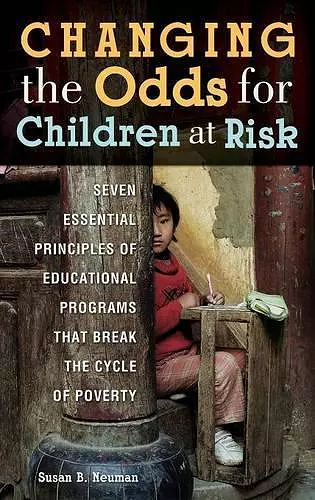Changing the Odds for Children at Risk
Seven Essential Principles of Educational Programs that Break the Cycle of Poverty
Format:Hardback
Publisher:Bloomsbury Publishing PLC
Published:30th Nov '08
Currently unavailable, and unfortunately no date known when it will be back

Shows how the rhetoric of leaving no child behind has trumped reality, why low achievement is not a failure of the legislation or of the schools but is instead rooted in economic inequality and social pathologies too deep to be overcome by schools themselves, unless we turn our attention, time and money to programs that are indeed making a difference in children's lives nationwide.
In these pages, however, Neuman shows how the odds can be changed, how we can break the cycle of poverty and disadvantage for children at risk After laying the critical groundwork for the need for change—excessive waste with little effect—this book provides a vivid portrait of changing the odds for high-poverty children.
Schools, today, are in the midst of the most major, costly educational reform movement in their history as they grapple with the federal mandates to leave no children behind, says author Susan B. Neuman, former Assistant Secretary for Elementary and Secondary Education under President George W. Bush. Although some efforts for investing resources will be substantially more productive than others, there is little evidence that, despite many heroic attempts to beat the odds, any of these efforts will close more than a fraction of the differences in achievement for poor minority children and their middleclass peers.
As Neuman explains in this insightful, revealing book, schools will fail, not due to the soft bigotry of low expectations, but because there are multitudes of children growing up in circumstances that make them highly vulnerable. Children who come to school from dramatically unequal circumstances leave school with similarly unequal skills and abilities.
In these pages, however, Neuman shows how the odds can be changed, how we can break the cycle of poverty and disadvantage for children at risk After laying the critical groundwork for the need for change—excessive waste with little effect—this book provides a vivid portrait of changing the odds for high-poverty children. Describing how previous reforms have missed the mark, it offers a framework based on seven essential principles for implementing more effective programs and policies.
Building on successes while being fiscally responsible is a message that has been shown to have wide bipartisan appeal, embraced by both liberals and conservatives. Following Neuman's essential principles, chapters describe programs for changing the odds for children, when the cognitive gaps are beginning to form, in these earliest years of their lives. In a highly readable style, Neuman highlights programs that are making a difference in children's lives across the country, weaving together narratives that tell a compelling story of hope and promise for our most disadvantaged children.
"Extremely well written, this book belongs in libraries supporting educators, parents, researchers, and policy-makers." - Library Journal
"Neumann writes a practical book of solutions, as offered through her "seven essentials" for changing the odds for at-risk kids and their families. These aren't theories. These are principles of educational programs that are proving themselves to work in several different places around the country. ... Her ideas are the type of educational stimulus plan needed to save the futures of millions of young Americans who otherwise may perish." - MultiCultural Review
"Every educator--experienced, as well as novice--will rejoice at the thought that things can improve, and moreover, are improving in the education of every child, regardless of material goods or social standing. Neuman presents a blueprint for every child in America." - Catholic Library World
"Neuman refers to her audience as 'policy makers, practitioners, parents, and community leaders' who could help disadvantaged children (p. 70). However, readers interested in principles based on empirical studies and calls for action from those qualified to perform educational and performance-based testing, longitudinal studies, program assessment, individual testing, correlation studies, and research design assessment would also find this book useful. . . . Neuman successfully achieves what seems to be the book’s purpose, to convince readers that there is enough funding already in place to help children at risk, that programs exist that can help at-risk children, and that programs that cannot bring forth fruits of success should be jettisoned." - PsycCRITIQUES
ISBN: 9780313362224
Dimensions: unknown
Weight: unknown
240 pages